#Power Plate# #Green Power# #Power Marketization# $Three Gorges Energy(SH600905)$ $Yangtze River Power(SH600900)$
In the analysis articles of the first three Three Gorges Energy series ( Three Gorges Energy Analysis (1) – operating items, operating profit, etc. , Three Gorges Energy Analysis (2) – Finance , Three Gorges Energy Analysis (3) – Yangtze Power is on the left, Three Gorges Energy is on the right ) The author analyzes the two companies of Three Gorges Energy and Yangtze Power from the perspectives of business, finance, and the comparison of Yangtze Power and Three Gorges Energy.
The development of enterprises is inseparable from the overall environment. Therefore, this article puts the two enterprises of Yangtze Power and Three Gorges Energy under the general environment of the power market system, and analyzes the two enterprises in combination with the two business models of hydropower and wind power.
It should be noted that when writing this article, the author strives to search and select references and information in the past two years (2020-2022) to ensure the accuracy and timeliness of the analysis. However, due to the limitation of information acquisition channels, there may be errors or incomplete information in this article. Professionals and readers who read this article should also correct me.
1. Electricity market
1. Frame
The electricity market system can be divided into two systems, one is the pricing system and the other is the regional system.
The pricing system is divided into a planning system and a market system. The planning system is priced by the government, and the power grid companies purchase and sell in a unified manner. The main customers are residents and agricultural users. The provincial development and reform commissions provide price subsidies to these users according to the on-grid electricity prices of different power sources; the market system is a market-oriented electricity price formed by multiple electricity users through independent negotiation and centralized bidding within the floating range set by the government. The customers of this system are non-resident and agricultural users such as industrial and commercial enterprises.
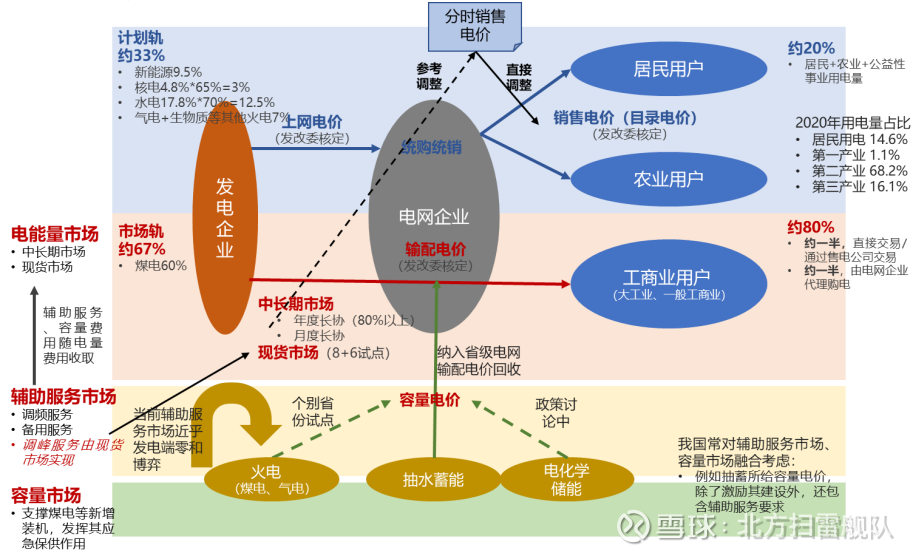
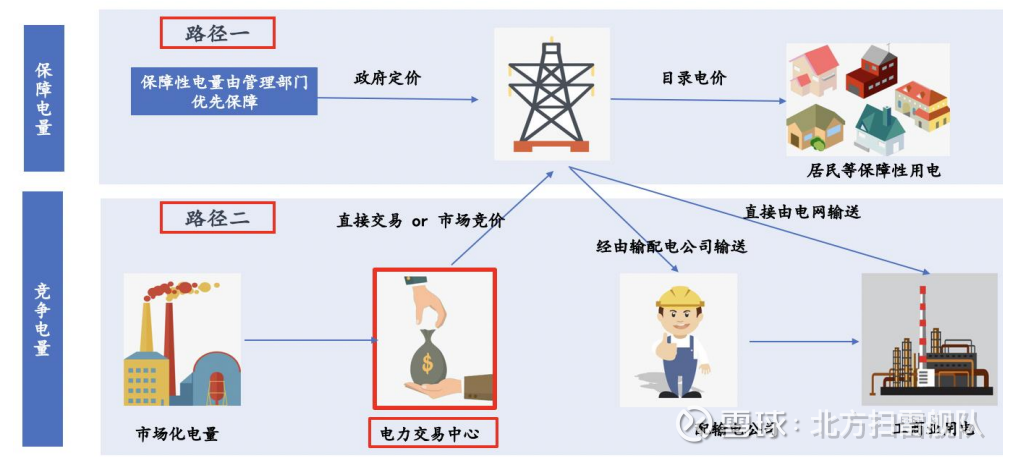
The market system specifically includes multiple levels of market structures such as the electricity energy market, the auxiliary service market, the spot market, and the medium and long-term trading market.
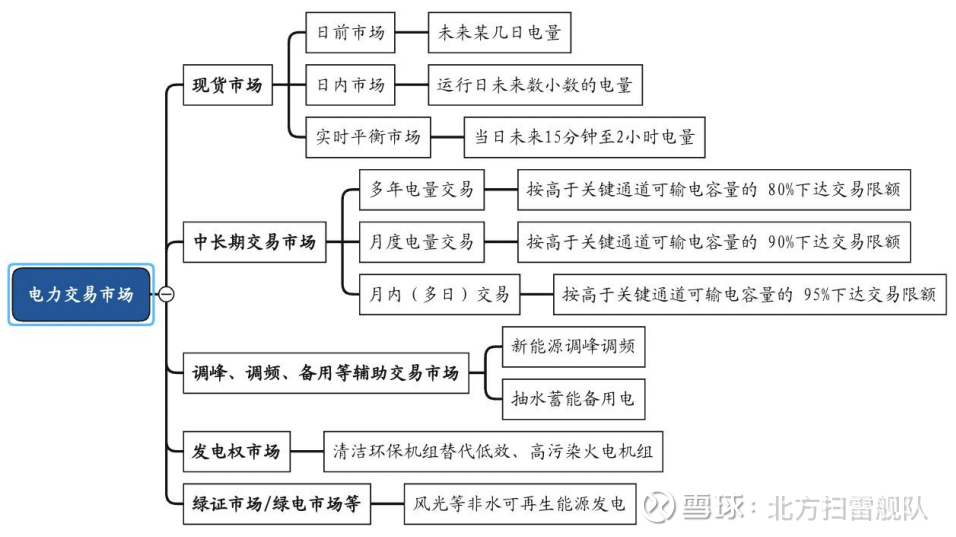
The spot market mainly conducts energy transactions in the short term (days to minutes). Guide the rational allocation of resources in a short period of time and improve resource utilization. The real-time deviation of the power grid can realize the instantaneous balance of power supply and demand through transactions in the spot market. At present, the spot market is in the pilot operation stage, and is gradually operating in conjunction with the medium and long-term market.
The medium and long-term trading market mainly conducts electricity energy trading, flexibly conducts power generation right trading, contract transfer trading, and conducts power transmission rights and capacity transactions according to market development needs. At present, electricity market transactions are mainly based on medium and long-term transactions, mainly in the province.
The auxiliary trading market (mainly for thermal power plants and other power systems such as electrochemical energy storage, this article mainly discusses hydropower and wind power, so it is briefly introduced) mainly to maintain the real-time balance of power generation and power consumption, so as to ensure that the frequency of the grid is relatively constant. Peak frequency regulation, and some pumped storage transactions. On December 21, 2021, the National Energy Administration revised and issued the “Administrative Measures for Electric Power Auxiliary Services”, focusing on supplementary and deepening of auxiliary service providers, transaction types, sharing and sharing mechanisms for electricity users, and inter-provincial and inter-regional auxiliary service mechanisms. The specific amendments and the subsidy mechanism are as follows:
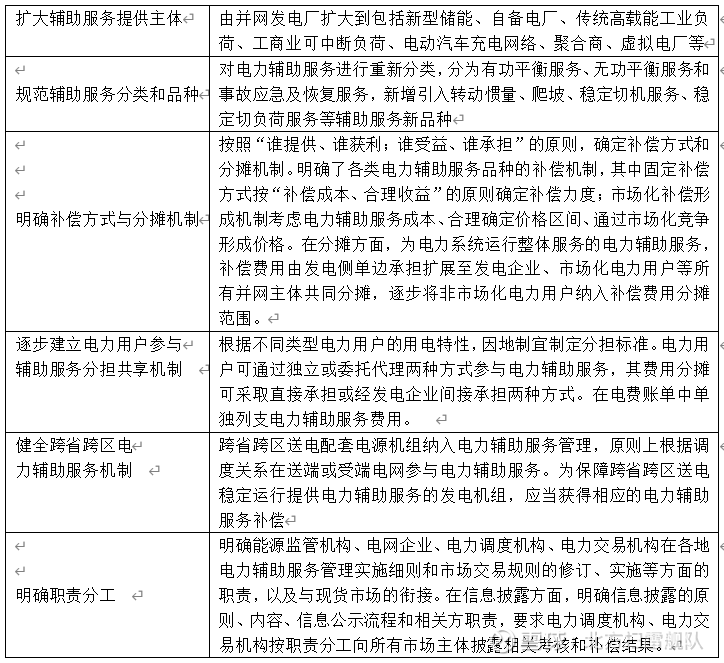
The power generation right transaction refers to the transaction behavior in which power generation enterprises transfer contracted power such as base power contracts and priority power generation contracts to other power generation enterprises through the trading platform established by electricity market transactions, through bilateral negotiation, centralized bidding, listing and other market-oriented methods. It is characterized by the replacement of fossil energy units with clean energy units. In principle, large-capacity, high-parameter, environmentally friendly units will replace low-efficiency, high-polluting thermal power units and shut down generators for power generation, and clean energy generators such as water, wind, light, and nuclear power will replace low-efficiency, high-polluting thermal power units.
The green power market refers to a medium- and long-term power trading market with green power products (currently mainly wind-solar non-hydro power, which is expected to be included in hydropower in the future) as the target to meet the needs of power users to purchase and consume green power.
The regional system refers to the intra-provincial market and the inter-provincial market. The two-level market has not yet realized the linkage operation. Generally, the inter-provincial market first clears the supply and demand, and the clearing result serves as the boundary of the provincial market, and then the domestic market further clears the supply and demand.
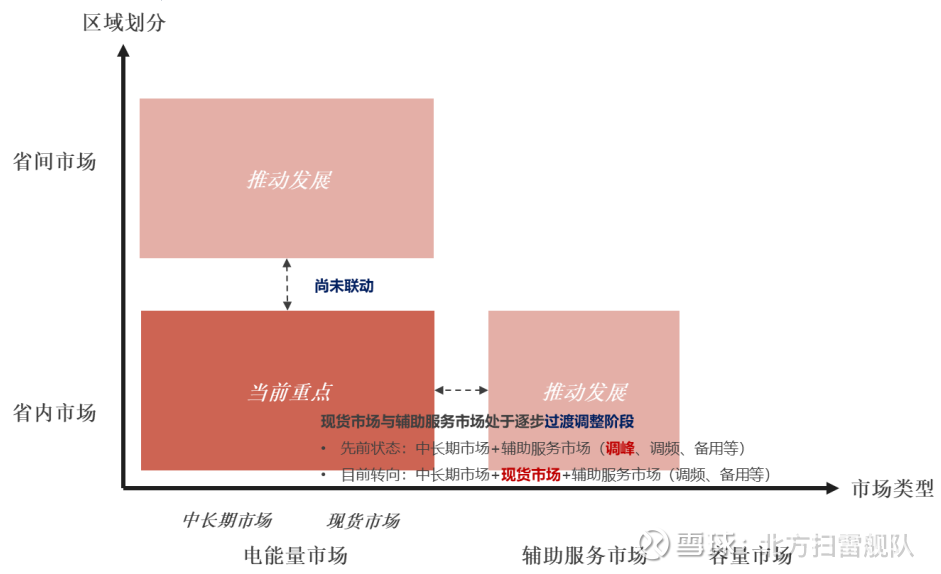
2. Price
According to the above introduction, the price introduced here refers to the price in the market system, including the market price of electric energy, capacity price, auxiliary service price and cost compensation.
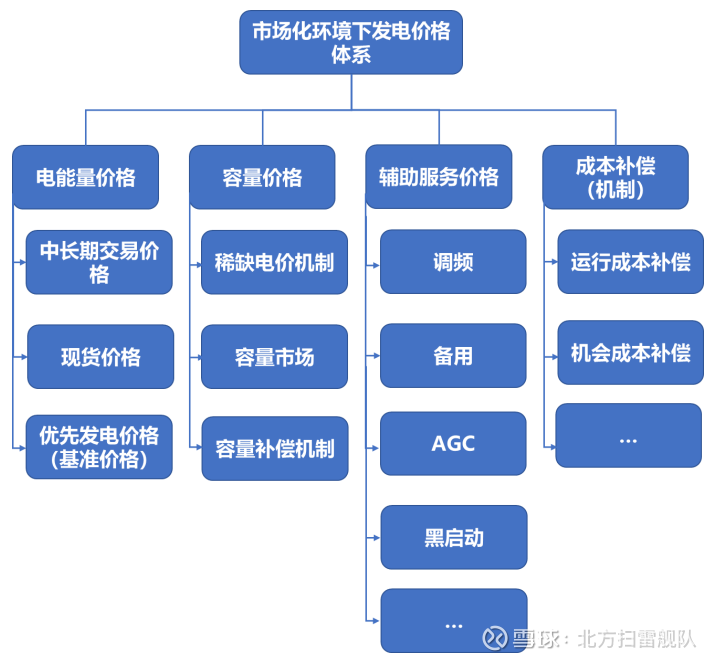
Electricity energy price consists of medium and long-term transaction price, spot transaction price and priority generation price.
Medium and long-term transaction prices. Medium and long-term market transactions mainly refer to market transaction entities such as power generation enterprises, electricity sales enterprises, power users and independent auxiliary service providers that meet the access conditions. The above electricity energy transaction. The price formed through mid- and long-term market transactions is called the mid- and long-term transaction price, and is applicable to direct electricity transactions, cross-province and cross-regional transactions (referring to crossing the power generation dispatch control area), and contract electricity transfer transactions carried out in various parts of the country at the current stage. At present, my country’s medium and long-term power transactions are mainly based on bilateral negotiation transactions and centralized bidding transactions, supplemented by listed transactions.
Spot transaction price. The spot market mainly includes day-ahead, intra-day and real-time electric energy, and the price formed through the spot market transaction is called the spot transaction price. From the perspective of transaction time, the spot market can be divided into day-ahead market, intra-day market and real-time market; from the perspective of pricing form, the spot market pricing mechanism is based on short-term marginal cost, and is roughly subdivided into system marginal pricing according to transmission line constraints , regional marginal pricing and node marginal pricing, the three pricing mechanisms are suitable for wholesale electricity markets with different grid structures and transmission congestion.
Priority generation price. After the reform, part of the power generation exists in the form of “planned power” or “base power”, which is arranged by the dispatching agency according to the priority power generation, the priority power purchase plan and the actual operation needs of the power grid. This part of the electricity is still purchased by power grid companies and settled according to the on-grid electricity price (benchmark electricity price) approved by the government.
The capacity price consists of a scarce electricity price mechanism, a capacity market and a capacity compensation mechanism. The emergence of capacity prices is a mechanism for regulating power abundance due to the power generation efficiency of different power sources and the need to reduce power waste.
Scarcity electricity price mechanism refers to a method that does not set up a capacity market or capacity mechanism, and relies on a single electricity energy market to solve the problem of abundant power generation resources. The market has no upper limit price or the upper limit price is very high. In the case of scarcity of system electric energy and reserve, the price of electric energy can rise rapidly and sharply, and the demand for power recovery investment can be met through a short-term high price to encourage investment in new power plants.
The capacity market is a market mechanism for pricing capacity. It is a new market established outside the single electric energy market to ensure that the power system meets clear reliability standards.
The capacity compensation mechanism is an administrative capacity cost recovery mechanism in which the regulatory agency sets the capacity price and compensable capacity and recovers the fixed cost for the generator set. Mainly under the guidance of the government or regulatory agencies, the unit capacity compensation standard and the compensable capacity of each unit are determined according to factors such as load forecast, user power outage loss assessment, system reliability standards and generator unit availability, so as to make reasonable compensation for the cost of power generation capacity. A typical example is the Chilean electricity market capacity compensation mechanism, which is a beneficial supplement to the spot market on the competitive power generation side through economic regulation. The generator set obtains monthly capacity compensation according to the compensable capacity and compensation price, and the total income is the sum of the electric energy income and the capacity income.
The main source of the price of ancillary services is peak regulation and frequency regulation. The revised “Administrative Measures for Electric Auxiliary Services” reclassifies electric auxiliary services into active power balancing services, reactive power balancing services, and accident emergency and recovery services. New varieties of auxiliary services such as load services. The compensation and apportionment of electric auxiliary services can be formed by fixed compensation and marketization in two ways, which are included in the user’s electricity price and separately listed in the transaction electricity price.
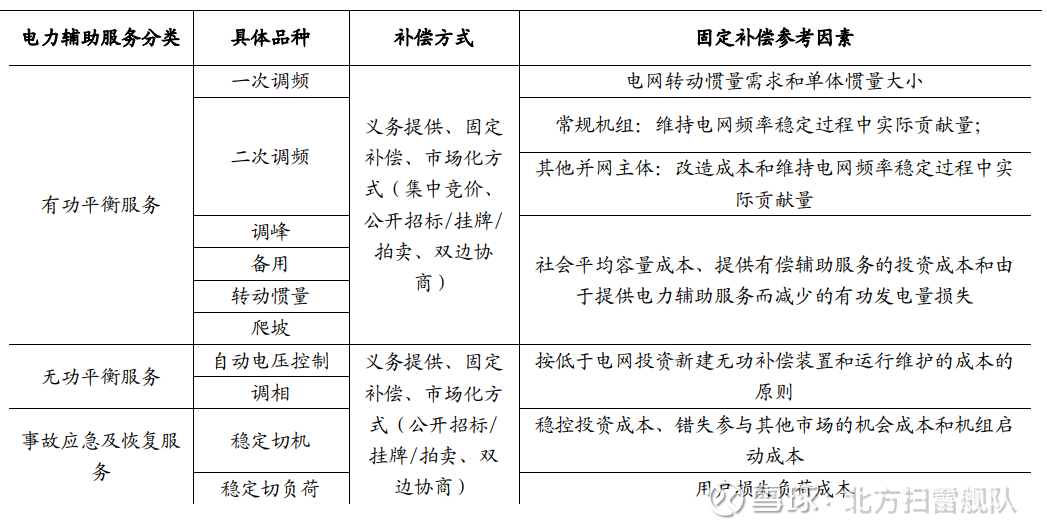

The cost compensation mechanism is mainly composed of two mechanisms: operating cost and opportunity cost compensation.
The operating cost compensation mechanism means that when the unit operating according to the dispatch instruction cannot recover the operating cost through the electricity cost, the market will compensate it according to its quoted cost or approved cost. Operating costs include start-stop, no-load and other costs. Operating cost compensation is divided into day-ahead market operating cost compensation and real-time market operating cost compensation. The day-ahead market operation cost compensation means that if a unit is called up according to the date market clearing result, but the electric energy revenue in the day-ahead market cannot cover its cost, it can be compensated. Real-time market operation cost compensation refers to the cost compensation of eligible units in the real-time market to make up for the difference in cost and income.
Opportunity cost compensation means that in the real-time market, the generator reduces the load according to the scheduling requirements due to the influence of constraints and other reasons, and compensates for the opportunity cost of the loss of the unit. Opportunity cost compensation includes ancillary service opportunity cost and dispatch intervention opportunity cost. The idea of compensation is to ensure the profit of its normal participation in the electric energy market.
2. Yangtze Power under the hydropower business model and Three Gorges Energy under the wind power business model
After understanding the entire electricity market and electricity price system, this paper will analyze the Yangtze River Power and the Three Gorges Energy in combination with the business models of hydropower and wind power, respectively. It needs to be clear that the above introduction is the overall power market system, so it will also include the operation and price mechanism of thermal power; since this article mainly introduces hydropower and wind power, this article will selectively select parts of the system introduced above content, which is analyzed as a background.
1. Yangtze Power under the hydropower business model
Let us first introduce the business model of hydropower. Business model refers to: there are various transaction relationships and connection methods between enterprises, between departments of enterprises, and even between customers and channels. In a nutshell, a business model is how a business makes money and how it operates.
The principle of hydropower is to convert water energy into kinetic energy, and finally into electrical energy. Therefore, hydropower has three elements: flow, water level, and turbine efficiency. The output power of hydropower depends on the flow rate of the turbine, the water level difference between the upstream and downstream of the reservoir, and the efficiency of the turbine unit. The outflow flow of the turbine is related to the inflow flow and water level, and the inflow flow is closely related to the incoming water, which is related to the upstream weather (rainfall and air temperature); the water level difference between the upstream and downstream of the reservoir depends on the resource endowment and The topography of the dam construction site. In summary, the greater the flow through the turbine, the greater the water level difference between the upstream and downstream of the dam, and the longer the power generation time, the more power will be generated.
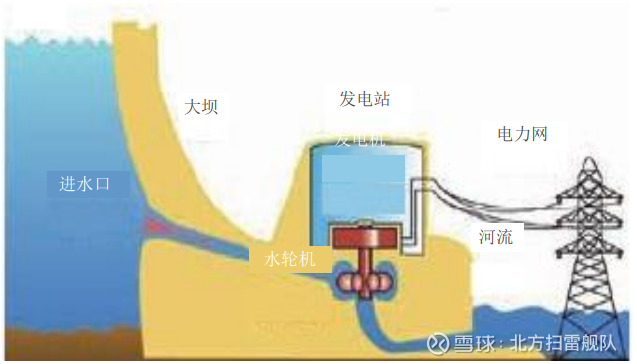
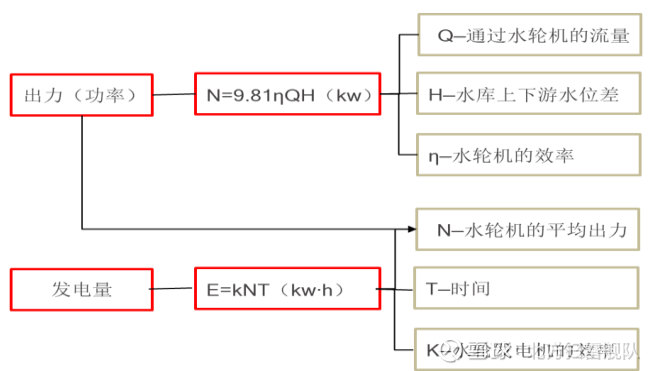
The profits of hydropower enterprises are mainly composed of main business income and non-operating income. The main business income refers to the income from the sale of electricity, which is composed of power generation and on-grid electricity price. The power generation depends on the installed capacity and utilization hours, and the utilization hours mainly depends on the amount of incoming water. The on-grid electricity price includes three modes: the independent electricity price set according to the “principal repayment price” or the “operating period electricity price”, the benchmark electricity price implemented within the province, and the negotiated electricity price for inter-provincial and inter-regional power transmission. Inter-provincial mid- and long-term hydropower transactions are mainly based on inter-governmental agreements and national mandatory plans, mainly inter-provincial delivery transactions by listing and bilaterally negotiated power generation rights transactions. According to the needs of the flood season, some emergency hydropower transactions are also included. Medium and long-term transactions in the province are carried out on the provincial trading platform according to the annual, monthly and intra-month cycles. Typical transaction methods include: centralized matching transactions, listed transactions, direct transactions and other forms. Each province has its own characteristics of hydropower transactions according to specific conditions. The large hydropower provinces such as Sichuan and Yunnan have large market-oriented hydropower transactions, and other receiving provinces generally consume hydropower as a priority power generation resource with guaranteed quantity and guaranteed price. ” emergency transactions to consume excess hydropower. Spot trading has carried out inter-provincial surplus renewable energy spot trading and pilot construction of spot markets in Sichuan and other places.
Non-operating income is mainly government subsidies.
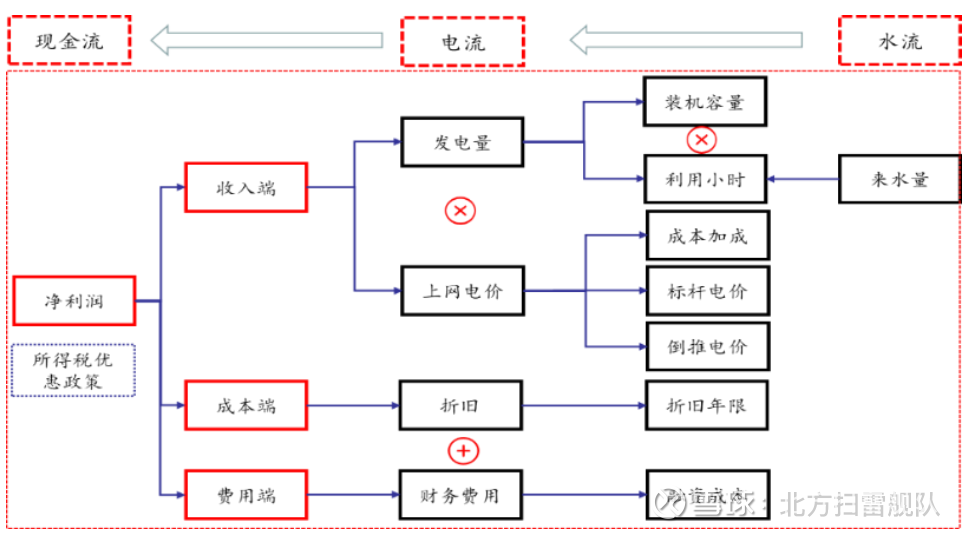
Because hydropower has the characteristics of flexible adjustment and obvious seasonal characteristics, there is a problem of consumption of hydropower, that is, to solve the problem of abundant hydropower.
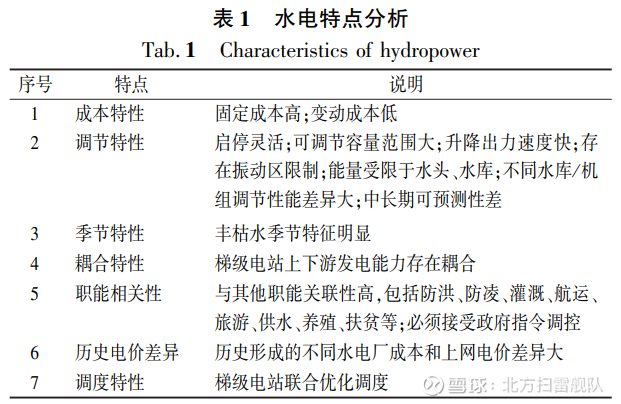
According to the different consumption methods, the current electricity price of each hydropower station is also different. The consumption of hydropower in the province can be divided into market-oriented transaction electricity and non-market-oriented transaction electricity, corresponding to the market-oriented electricity price and the non-market-oriented electricity price in the province. In the external power transmission, the power in the contract is generally the negotiated power price for inter-provincial and cross-regional power transmission. The excess power generation outside the contract may refer to the market-based transaction price of the landing province or take the average market-based transaction price of the two provinces for pricing.
The costs of hydropower enterprises are mainly composed of depreciation (houses and buildings, power generation equipment, water retaining structures), maintenance fees, water fees (reservoir area maintenance funds, water resources fees) and employee compensation (salaries, welfare fees). Among them, 60% are fixed costs, and reservoir area resource fees, water resources fees, various financial fees, material fees and labor costs are variable costs. In general, the cost of hydropower enterprises presents a pattern of “high first and then low”. The initial cost of dam construction is high, including construction costs, relocation costs and other costs; after the dam is completed, its depreciation will be apportioned to each fiscal year, and it will not be accrued until the depreciation is completed. The depreciation period of a building is 40-60 years, and its service life is generally about 100 years (the Hoover Dam in the United States built in 1936 has been in use for 86 years and is still in use), so the depreciation cost is reduced year by year.

The maintenance fee and water fee are generally negligible. The maintenance fee is generally normalized maintenance. As long as the dam is well preserved, the cost will not be very high. The water fee is relatively small and can be recycled. Among them, the maintenance of the reservoir area The fund is levied at the standard of no higher than 0.8 cents per kWh according to the actual online sales of electricity by the reservoir, and the water resource fee is levied at the standard of 0.3-0.8 cents per kWh.
Employee expenses are generally dynamic and can be controlled at 5% of operating income.
2. Three Gorges Energy under the wind power business model
The principle of wind power generation is: wind energy → mechanical kinetic energy → electrical energy. According to Bates’ law, the highest wind energy utilization efficiency is about 59%, but considering the energy loss in the actual power generation process, the actual wind energy utilization rate is about 30~50%.
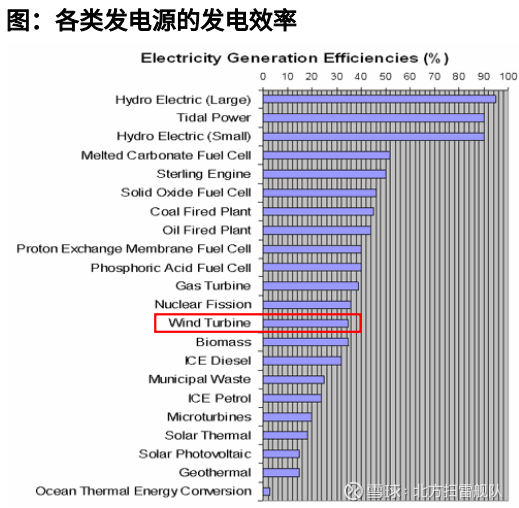
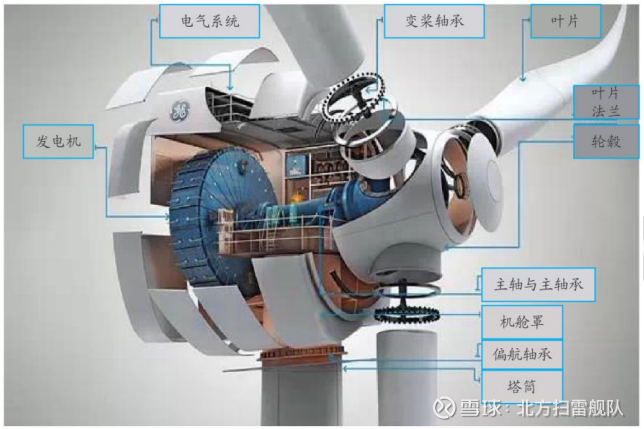
Offshore wind power has more advantages than onshore wind power. First, there is sufficient offshore wind energy, there are no obstacles to block wind energy transfer, and the utilization rate of fans is high; second, transportation is more convenient, and large-tonnage transport ships can be mobilized, so the single machine capacity is large; third, The sea breeze is not disturbed by obstacles, so it is more stable than the land wind, and the fan operation is more stable.

The development of electricity price of wind power is a process of gradual marketization. From 2021, the central government will no longer subsidize newly approved onshore wind power projects and implement grid parity. The on-grid electricity price of new projects in 2021 shall be implemented according to the local benchmark price of coal-fired power generation; new projects can voluntarily participate in market-based transactions to form on-grid electricity prices. From 2021 onwards, for newly approved (recorded) offshore wind power projects, the on-grid electricity price shall be set by the local provincial pricing authority, which can be formed through competitive allocation if conditions permit. If the on-grid electricity price is higher than the local benchmark price of coal-fired power generation, the on-grid electricity price shall be within the benchmark price. The part is settled by the power grid company.
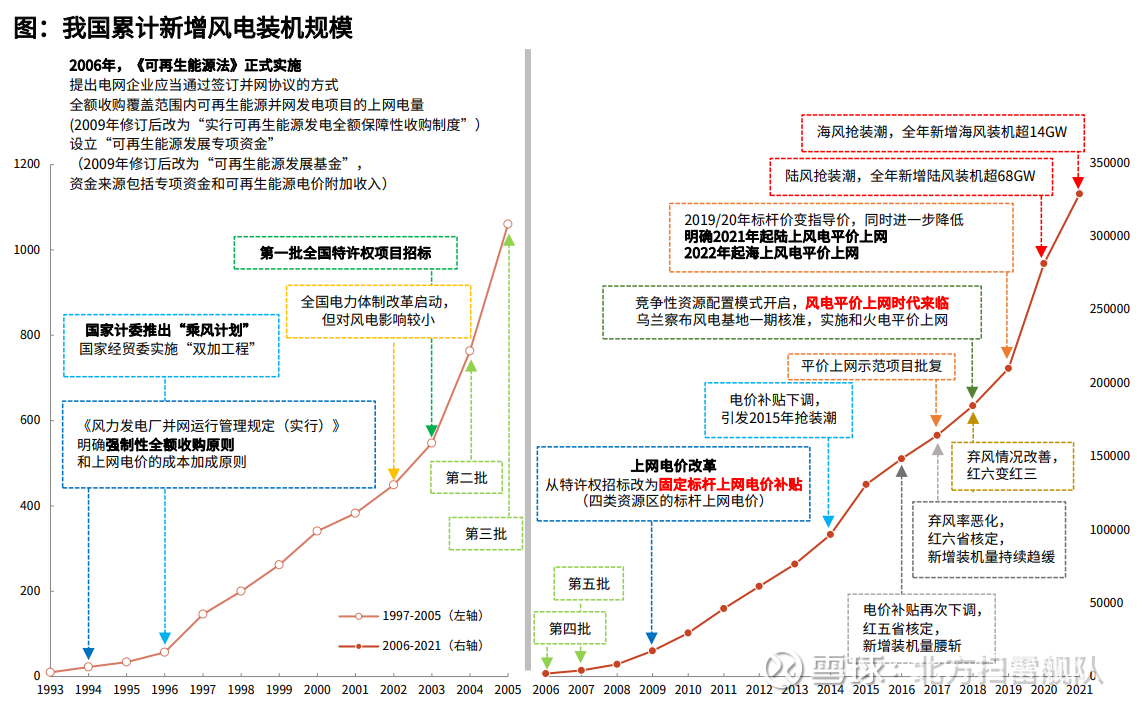
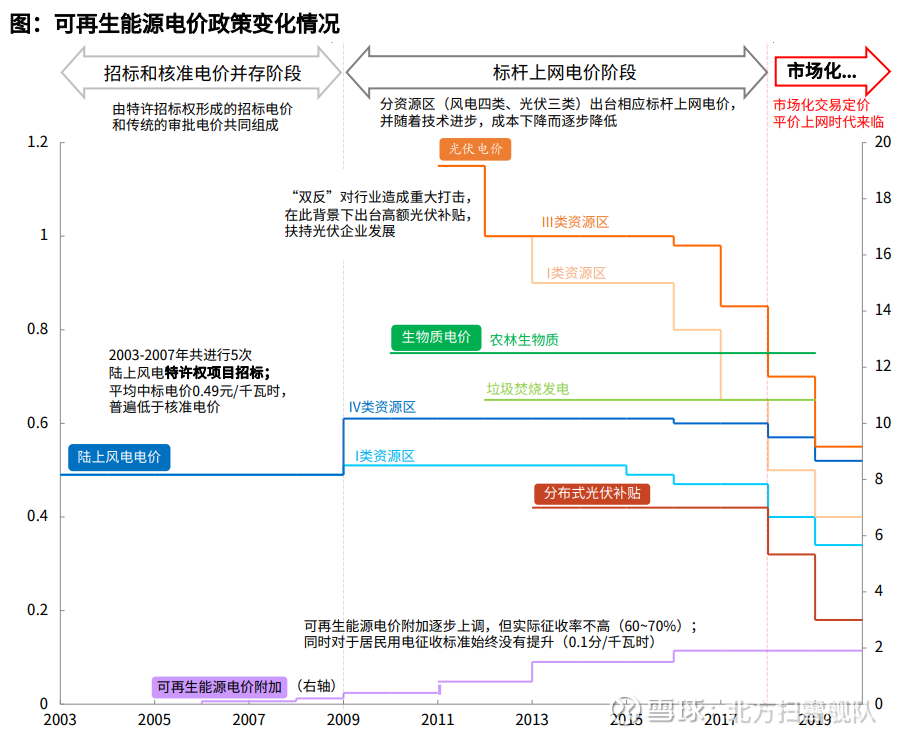
In terms of cost, the cost of wind power mainly includes operation and maintenance costs, loan interest and tax costs. The service life of wind power equipment is generally about 20 to 30 years.
One of the ways to reduce costs is to increase the size of wind power equipment. The increase in the capacity of a single unit means a larger swept area and a higher hub height, a lower cut-in wind speed, and more wind energy can be captured in the same geographical location, which can effectively increase the power generation of wind turbines in the whole life cycle; wind farms with the same capacity use Units with larger single-unit capacity can effectively reduce the investment costs of raw materials, foundation, hoisting, lines, land, etc. allocated to the unit capacity; larger-scale units will reduce the cost and difficulty of later operation, maintenance and management. Therefore, the large-scale unit will effectively reduce the LCOE of wind power generation. A larger single-machine capacity also means that a wind farm of the same capacity requires fewer wind turbines, and the corresponding wind turbine foundation, transportation, installation and maintenance costs are more significantly reduced.
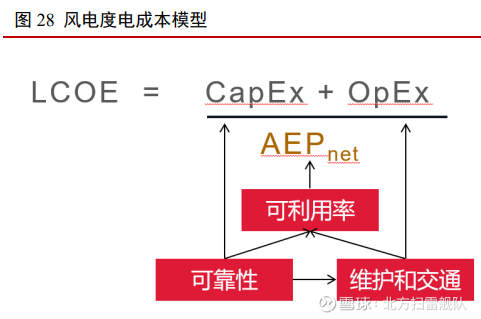
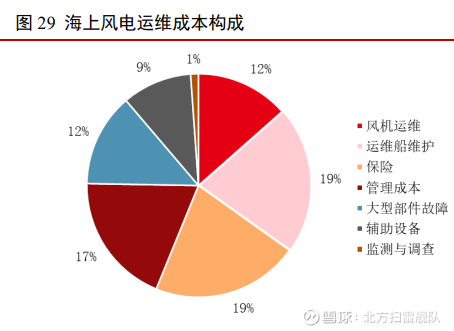
references
Gao Zhiyuan, Xu Liang, Shao Ping, Xu Jun, Xue Kunyuan, Sun Qian, Shi Shuhong. Hydropower marketization analysis and system framework design [J]. People’s Yangtze River, 2022,53(01):235-239.DOI:10.16232 /j.cnki.1001-4179.2022.01.036.
Chen Haoyong, Xi Songtao. Cost composition and price mechanism of offshore wind power[J].Wind Energy,2022(01):12-15.
Cai Yu, Xiao Yanwei, Zhang Guofang, Chang Li, Xu Hongqiang, Chang Naichao.Technical architecture design of technical support system for provincial electricity spot market[J].Automation of Electric Power Systems,2021,45(06):176-185.
[National Energy Administration] Annual Report on China’s Coal, Electricity and Carbon Markets (2021 Summary and 2022 Outlook)
[Huatai Securities] Hydropower will become stronger as time goes by, or meet the inflection point of depreciation
[Everbright Securities] Wind Power Industry: Investment Logic and Framework
[Hua Chuang Securities] Decoding China’s power system to see where the reform of power marketization is headed
[Beijing Capital Securities] The horn of offshore wind power blew, and the subdivision leader set sail with the wind,
[Huatai Securities] Marketization of electricity prices is deepening, and coal power/nuclear power is more flexible
[Great Wall Securities] Electricity Market Reform Deep Water Area, Capacity Price of Cost Recovery Mechanism Reform – Carbon Neutral Series Report (2)
【Cinda Securities】Structure, Mechanism and Investment Opportunities of my country’s Electricity Market
[Soochow Securities] Wind power equipment: Offshore wind power will become an important driving force in the industry, pay attention to leading companies of high-quality parts and components
[Guorong Securities] Policy-driven development, infinite scenery is at this peak – an in-depth report on the wind power industry
[Guohai Securities] Auxiliary services for the power market: marketization is imperative, and the 100 billion market is expected to open
This topic has 4 discussions in Snowball, click to view.
Snowball is an investor’s social network, and smart investors are here.
Click to download Snowball mobile client http://xueqiu.com/xz ]]>
This article is reproduced from: http://xueqiu.com/1661773330/223032041
This site is for inclusion only, and the copyright belongs to the original author.